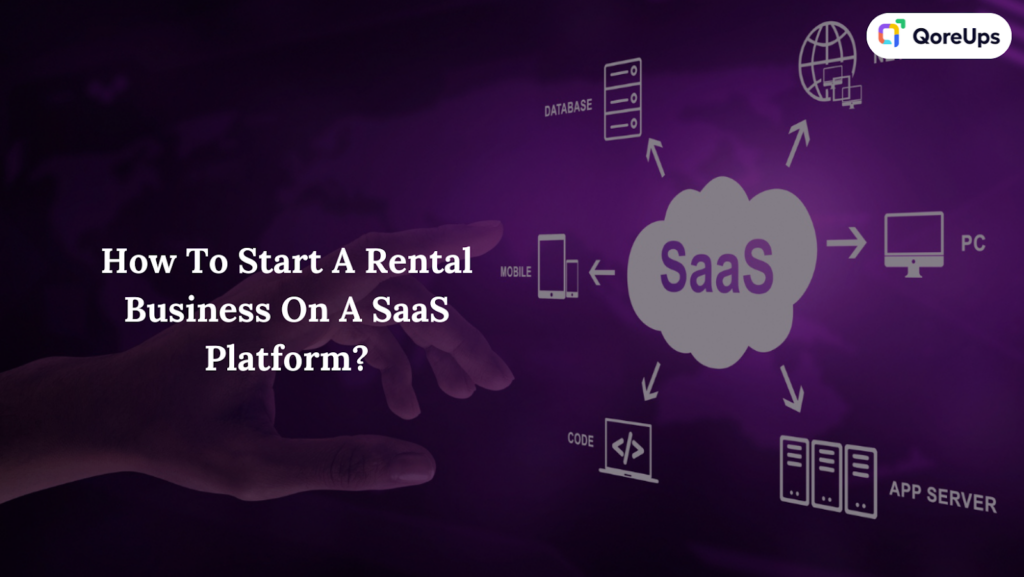
Starting a rental business on a SaaS platform is a lucrative venture, towards the growing trend of the sharing economy and digital transformation.
Whether you plan to rent out properties, equipment, vehicles, or other goods, a SaaS platform is the helpful one to streamline operations, manage bookings, process payments, and scale your business efficiently.
In this comprehensive guide, we’ll cover the steps needed to launch and grow a successful rental business on a SaaS platform, along with key strategies and tips.
What Is A SaaS Platform?
A Software as a Service (SaaS) platform is a cloud-based software delivery model where applications are hosted by a third-party provider and made available to customers over the Internet.
In this model, users access the software through a web browser or application interface, rather than installing and maintaining it on their local devices.
7 Key Characteristics of SaaS Platforms
- SaaS platforms are easily accessible. You only need internet access. This accessibility allows users to access the rental software from any location and on any device, including computers, tablets, and smartphones.
- The SaaS marketplace business model works on a subscription basis. Customers pay a recurring fee (monthly or annually) for access to the software. This pricing model often includes updates, maintenance, and support services.
- SaaS applications are built to serve multiple customers (tenants) from a single shared instance of the software. This multi-tenancy architecture allows for efficient resource utilization and scalability.
- SaaS providers are responsible for managing and maintaining the underlying infrastructure, including hardware, software, and security updates. This relieves customers of the burden of software maintenance and ensures they always have access to the latest features and enhancements.
- SaaS platforms are designed to scale easily to accommodate changes in user demand. Providers can quickly allocate additional resources to meet growing customer needs without requiring users to upgrade or install new software.
- SaaS platforms often offer customization options and integrations with other software systems to meet the specific needs of individual customers. This flexibility allows businesses to tailor the rental marketplace software to their unique workflows and requirements.
- SaaS providers implement robust security measures to protect customer data and ensure compliance with industry regulations. This includes encryption, access controls, data backups, and regular security audits.
Getting SaaS platforms from skilled and long-term SaaS companies is essential to becoming a trendy player in the marketplaces.
Why B2B SaaS Company?
Let’s delve into reasons to prefer the B2B SaaS Company.
- Facilitating quick launches of marketplaces across diverse industry domains, offering options for rental, selling, services, classifieds, and multi-niche platforms on a country-specific basis.
- Feature-rich white-label SaaS marketplace platform empowering users to create online marketplace websites and mobile apps without extensive technical knowledge, tailored for peer-to-peer rentals, services, and product sales.
- Enabling businesses and entrepreneurs to build and customize their online marketplaces, versatile for e-commerce, rental services, booking platforms, and more.
Overall, SaaS platforms from the familiar B2B SaaS companies offer businesses a cost-effective and flexible solution for accessing and managing software applications, enabling them to focus on their core operations and drive business growth.
How To Start A Rental Business Using SaaS Platform
Starting a rental business using a SaaS platform has great advantages. Also, you have to be careful when starting it, because a blunder mistake will cost you a lot.
Step 1: Define Your Niche
Identifying your niche is the first critical step in establishing a successful rental business.
Your niche will not only determine what kind of items you are renting but also whom you are renting to.
Consider factors such as market demand, competition, profitability, and your interests and expertise.
For example, you might choose to focus on luxury vacation rentals, professional camera equipment, or party supplies.
Research and Analysis:
Conduct market research to validate your ideas. Look at market size, growth trends, competitor analysis, and customer demographics. Tools like Google Trends, industry reports, and surveys can be invaluable in this phase.
Step 2: Understand Regulatory Requirements
Every rental business must comply with local, state, and national regulations. These may include zoning laws, health and safety codes, licensing requirements, and insurance obligations.
Legal Framework:
Consult with a lawyer to understand the specific legal requirements for your chosen niche. You might need specific permits or licenses depending on the type of items you are renting.
Insurance:
Insurance protects both your business and your inventory. Consider what types of insurance (like liability, property, and loss of income insurance) are necessary for your operation.
Step 3: Set Up Your Business Model
Set up your rental marketplace business model. This will help you to decide how to structure prices and manage your inventory.
Will you charge per day, per hour, or project? What kind of deposits, if any, will you require?
Pricing Strategy:
Your pricing should reflect the value of your offerings, and market demand, and cover your costs while ensuring profitability. Consider dynamic pricing models where prices adjust based on demand and seasonality.
Inventory Management:
Effective inventory management is crucial, especially as your business scales. Your SaaS platform should help you track item availability, maintenance schedules, and turnover rates.
Step 4: Choose the Right SaaS Platform
Selecting the appropriate SaaS platform for your rental marketplace software is critical.
Because it will host your inventory, manage bookings, process payments, and serve as the interface for your customers.
Website and Integration:
Design a short-term rental software that is visually appealing, easy to navigate, and mobile-friendly. Ensure that it integrates seamlessly with your chosen SaaS platform for a smooth customer experience.
Key Features To Look For SaaS Rental B2B Marketplace Builder:
- User-friendly interface for both you and your customers
- Scalability to grow with your business
- Robust security features to protect your data and customer information
- Comprehensive booking management tools
- Integrated payment processing
- Support for mobile devices
Comparison and Trials:
Evaluate several platforms based on these features, costs, and reviews. Many SaaS Rental B2B Marketplace Builder providers offer free trials, which you can use to test their solutions before committing.
Step 5: Build an Effective Online Presence
Your online presence is your business’s face in the digital world. A strong, professional web presence can attract more customers and establish your brand’s credibility.
SEO and Content Marketing:
Implement search engine optimization (SEO) strategies to improve your website’s visibility in search results. Regularly publish relevant content, such as blog posts and articles, that addresses your target audience’s interests and needs.
Step 6: Marketing Your Rental Business
Effective marketing is key to attracting and retaining customers. Utilize both online and offline marketing strategies to reach a broader audience.
Digital Marketing:
Leverage social media, email marketing, PPC advertising, and influencer partnerships to promote your rentals. Tailor your messages according to the platforms and the audiences they reach.
Traditional Marketing:
Depending on your market, traditional methods like flyers, local newspaper ads, and partnerships with local businesses can be highly effective.
Customer Engagement:
Build relationships with your customers through excellent customer service, loyalty programs, and regular communication. Listen to their feedback and continuously improve your offerings based on their suggestions.
Step 7: Analyze and Optimize
Use analytics to monitor the performance of your rental business. Analyze data on sales, customer behavior, website traffic, and marketing campaign effectiveness.
Performance Metrics:
Key performance indicators (KPIs) might include occupancy rates, average rental duration, customer acquisition cost, and customer lifetime value. Use these metrics to make informed decisions about pricing, marketing, and inventory management.
Continuous Improvement:
Based on your analytics, refine your business processes and marketing strategies. Experiment with different approaches to see what works best for your business and customer base.
Conclusion
Starting a rental business on a SaaS platform involves careful planning and execution but can lead to significant rewards.
By choosing the right niche, complying with legal requirements, selecting a robust SaaS platform, and effectively marketing your business, you can establish a successful rental enterprise that grows and evolves.
Remember that the key to success in the rental industry lies in understanding your customers’ needs and continuously adapting to meet them. With dedication and strategic planning, your rental business can thrive in the dynamic and ever-expanding market landscape.
The post How To Start A Rental Business On A SaaS Platform? appeared first on noupe.



